大厂算法面试之 leetcode 精讲 14. 排序算法
- 2021 年 12 月 01 日
本文字数:9759 字
阅读完需:约 32 分钟
大厂算法面试之 leetcode 精讲 14.排序算法
视频讲解(高效学习):点击学习
目录:
常见排序算法复杂度
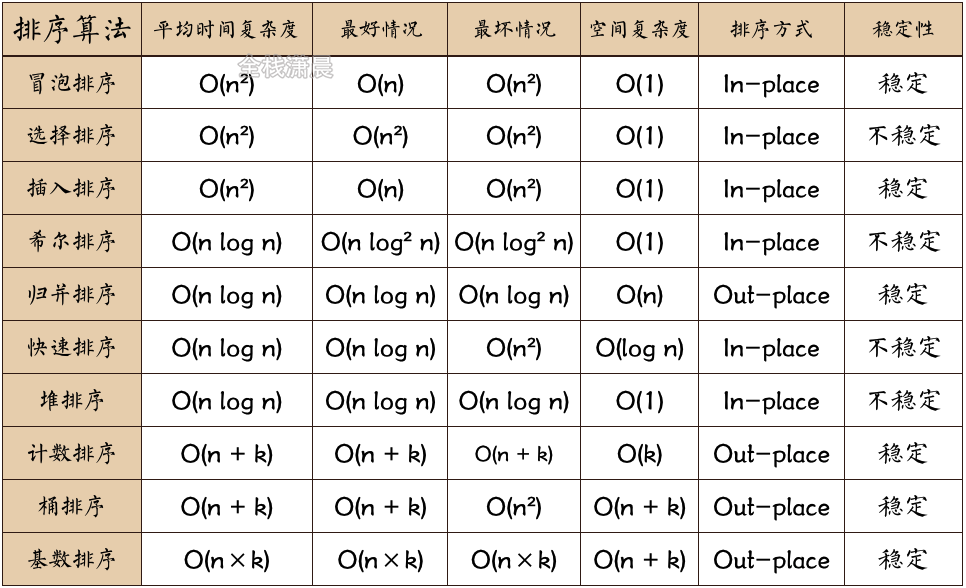
n^2 除 nlogn 在不同数据规模下的结果

常见排序算法
算法可视化来源:http://visualgo.net/
冒泡排序:时间复杂度 O(n^2)
比较相邻元素,如果第一个比第二个大,则交换他们
一轮下来,可以保证最后一个数是最大的
执行 n-1 轮,就可以完成排序

function bubbleSort(arr) { var len = arr.length; for (var i = 0; i < len; i++) { for (var j = 0; j < len - 1 - i; j++) { if (arr[j] > arr[j+1]) { //相邻元素两两对比 var temp = arr[j+1]; //元素交换 arr[j+1] = arr[j]; arr[j] = temp; } } } return arr;}
选择排序:时间复杂度 O(n^2)
找到数组中的最小值,将它放在第一位
接着找到第二小的值,将它放在第二位
依次类推,执行 n-1 轮

function selectionSort(arr) { var len = arr.length; var minIndex, temp; for (var i = 0; i < len - 1; i++) { minIndex = i; for (var j = i + 1; j < len; j++) { if (arr[j] < arr[minIndex]) { //寻找最小的数 minIndex = j; //将最小数的索引保存 } } temp = arr[i]; arr[i] = arr[minIndex]; arr[minIndex] = temp; } return arr;}
插入排序:时间复杂度 O(n^2)
从第二个数开始往前比
比它大就往后排
以此类推直到最后一个数
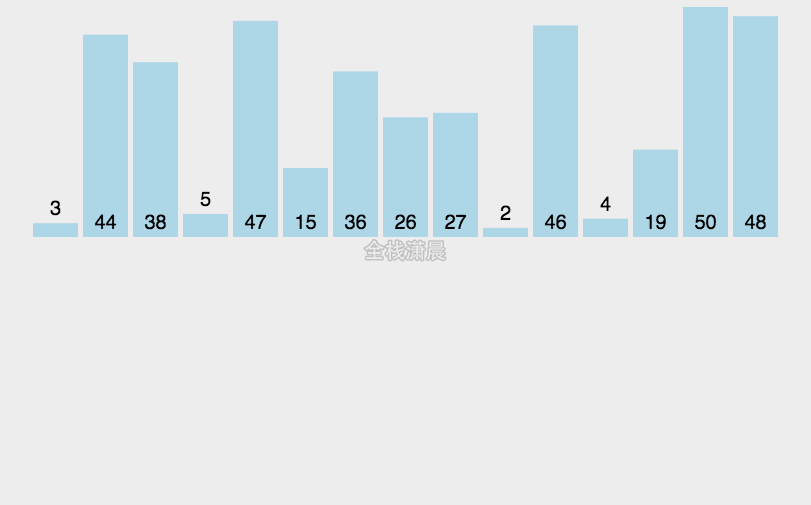
function insertionSort(arr) { var len = arr.length; var preIndex, current; for (var i = 1; i < len; i++) { preIndex = i - 1; current = arr[i]; while(preIndex >= 0 && arr[preIndex] > current) { arr[preIndex+1] = arr[preIndex]; preIndex--; } arr[preIndex+1] = current; } return arr;}
归并排序:时间复杂度 O(nlogn),分的时间复杂度O(logn),合并的过程的复杂度是O(n)
分:把数组分成两半,递归子数组,进行分割操作,直到分成一个数
合:把两个字数组合并成一个有序数组,直到全部子数组合并完毕,合并前先准备一个空数组,存放合并之后的结果,然后不断取出两个子数组的第一个元素,比较他们的大小,小的先进入之前准备的空数组中,然后继续遍历其他元素,直到子数组中的元素都完成遍历
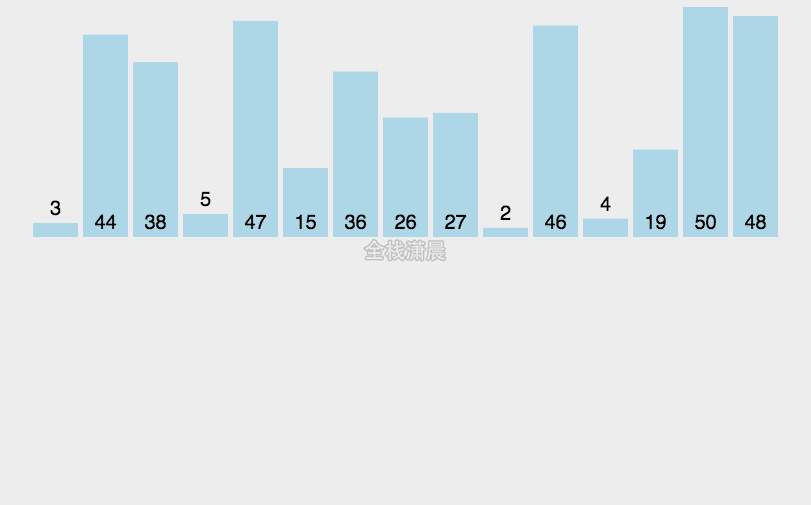
function mergeSort(arr) { //采用自上而下的递归方法 var len = arr.length; if(len < 2) { return arr; } var middle = Math.floor(len / 2), left = arr.slice(0, middle), right = arr.slice(middle); return merge(mergeSort(left), mergeSort(right));}
function merge(left, right){ var result = [];
while (left.length && right.length) { if (left[0] <= right[0]) { result.push(left.shift()); } else { result.push(right.shift()); } }
while (left.length) result.push(left.shift());
while (right.length) result.push(right.shift());
return result;}
快速排序:时间复杂度 O(nlogn),递归复杂度是O(logn),分区复杂度O(n)
分区:从数组中选一个基准值,比基准值小的放在它的前面,比基准值大的放在它的后面
递归:递归对基准值前后的子数组进行第一步的操作

function quickSort(arr, left, right) { var len = arr.length, partitionIndex, left = typeof left != 'number' ? 0 : left, right = typeof right != 'number' ? len - 1 : right;
if (left < right) { partitionIndex = partition(arr, left, right); quickSort(arr, left, partitionIndex-1); quickSort(arr, partitionIndex+1, right); } return arr;}
function partition(arr, left ,right) { //分区操作 //设定基准值位置(pivot)当然也可以选择最右边的元素为基准 也可以随机选择然后和最左或最右元素交换 var pivot = left, index = pivot + 1; for (var i = index; i <= right; i++) { if (arr[i] < arr[pivot]) { swap(arr, i, index); index++; } } swap(arr, pivot, index - 1); return index-1;}
function swap(arr, i, j) { var temp = arr[i]; arr[i] = arr[j]; arr[j] = temp;}
215. 数组中的第K个最大元素 (medium)
方法 1.维护大小为 k 的小顶堆,当堆的元素个数小于等于 k 时,遍历数组,让数组的元素不断加入堆,当堆的大小大于 k 时,让堆顶元素出列,遍历完数组之后,小顶堆堆顶的元素就是第 k 大元素。
复杂度:时间复杂度O(nlogk),循环 n 次,每次堆的操作是O(logk)。空间复杂度O(k),
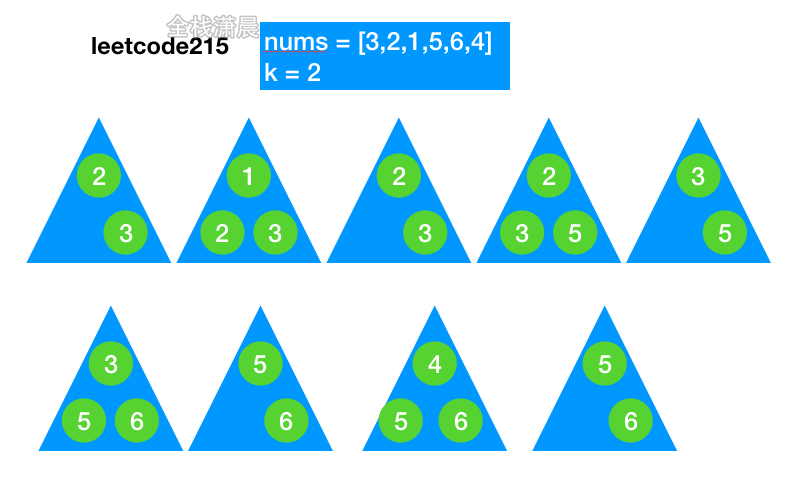
js:
class Heap { constructor(comparator = (a, b) => a - b, data = []) { this.data = data; this.comparator = comparator;//比较器 this.heapify();//堆化 }
heapify() { if (this.size() < 2) return; for (let i = Math.floor(this.size() / 2) - 1; i >= 0; i--) { this.bubbleDown(i);//bubbleDown操作 } }
peek() { if (this.size() === 0) return null; return this.data[0];//查看堆顶 }
offer(value) { this.data.push(value);//加入数组 this.bubbleUp(this.size() - 1);//调整加入的元素在小顶堆中的位置 }
poll() { if (this.size() === 0) { return null; } const result = this.data[0]; const last = this.data.pop(); if (this.size() !== 0) { this.data[0] = last;//交换第一个元素和最后一个元素 this.bubbleDown(0);//bubbleDown操作 } return result; }
bubbleUp(index) { while (index > 0) { const parentIndex = (index - 1) >> 1;//父节点的位置 //如果当前元素比父节点的元素小,就交换当前节点和父节点的位置 if (this.comparator(this.data[index], this.data[parentIndex]) < 0) { this.swap(index, parentIndex);//交换自己和父节点的位置 index = parentIndex;//不断向上取父节点进行比较 } else { break;//如果当前元素比父节点的元素大,不需要处理 } } }
bubbleDown(index) { const lastIndex = this.size() - 1;//最后一个节点的位置 while (true) { const leftIndex = index * 2 + 1;//左节点的位置 const rightIndex = index * 2 + 2;//右节点的位置 let findIndex = index;//bubbleDown节点的位置 //找出左右节点中value小的节点 if ( leftIndex <= lastIndex && this.comparator(this.data[leftIndex], this.data[findIndex]) < 0 ) { findIndex = leftIndex; } if ( rightIndex <= lastIndex && this.comparator(this.data[rightIndex], this.data[findIndex]) < 0 ) { findIndex = rightIndex; } if (index !== findIndex) { this.swap(index, findIndex);//交换当前元素和左右节点中value小的 index = findIndex; } else { break; } } }
swap(index1, index2) {//交换堆中两个元素的位置 [this.data[index1], this.data[index2]] = [this.data[index2], this.data[index1]]; }
size() { return this.data.length; }}
var findKthLargest = function (nums, k) { const h = new Heap((a, b) => a - b);
for (const num of nums) { h.offer(num);//加入堆 if (h.size() > k) {//堆的size超过k时,出堆 h.poll(); } }
return h.peek();};
方法 2:堆排序
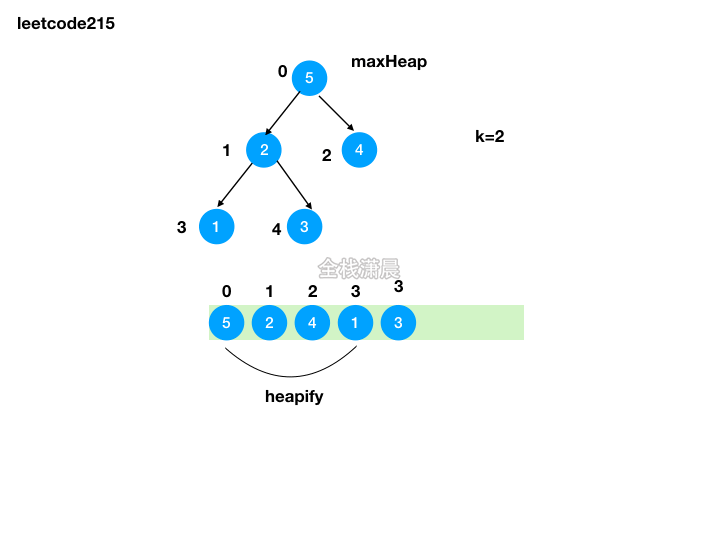
思路:利用原地堆排序的思想,将前 k-1 大的元素加入队尾,最后队顶的元素就是第 k 大的元素
复杂度:时间复杂度
O(nlogn),堆的创建复杂度是O(n),移动前 k-1 大的元素然后堆化复杂度是O(klogn),k<=n,最差的情况下是O(nlogn),空间复杂度O(logn),递归的栈空间
js:
var findKthLargest = function (nums, k) { let heapSize = nums.length; buildMaxHeap(nums, heapSize); //构建大顶堆 大小为heapSize //大顶堆 前k-1个堆顶元素不断和数组的末尾元素交换 然后重新heapify堆顶元素 //这个操作就是之前小顶堆出堆顶的操作,只不过现在是原地排序 for (let i = nums.length - 1; i >= nums.length - k + 1; i--) { swap(nums, 0, i);//交换堆顶和数组末尾元素 --heapSize; //堆大小减1 maxHeapify(nums, 0, heapSize);//重新heapify } return nums[0];//返回堆顶元素,就是第k大的元素
function buildMaxHeap(nums, heapSize) { for (let i = Math.floor(heapSize / 2) - 1; i >= 0; i--) {//从第一个非叶子节点开始构建 maxHeapify(nums, i, heapSize); } } // 从左向右,自上而下的调整节点 function maxHeapify(nums, i, heapSize) { let l = i * 2 + 1;//左节点 let r = i * 2 + 2;//右节点 let largest = i; if (l < heapSize && nums[l] > nums[largest]) { largest = l; } if (r < heapSize && nums[r] > nums[largest]) { largest = r; } if (largest !== i) { swap(nums, i, largest); //找到左右节点中大的元素交换 //递归交换后面的节点 maxHeapify(nums, largest, heapSize); } }
function swap(a, i, j) {//交换函数 let temp = a[i]; a[i] = a[j]; a[j] = temp; }};
java:
class Solution { public int findKthLargest(int[] nums, int k) { int heapSize = nums.length; buildMaxHeap(nums, heapSize); for (int i = nums.length - 1; i >= nums.length - k + 1; --i) { swap(nums, 0, i); --heapSize; maxHeapify(nums, 0, heapSize); } return nums[0]; }
public void buildMaxHeap(int[] a, int heapSize) { for (int i = heapSize / 2; i >= 0; --i) { maxHeapify(a, i, heapSize); } }
public void maxHeapify(int[] a, int i, int heapSize) { int l = i * 2 + 1, r = i * 2 + 2, largest = i; if (l < heapSize && a[l] > a[largest]) { largest = l; } if (r < heapSize && a[r] > a[largest]) { largest = r; } if (largest != i) { swap(a, i, largest); maxHeapify(a, largest, heapSize); } }
public void swap(int[] a, int i, int j) { int temp = a[i]; a[i] = a[j]; a[j] = temp; }}
方法 3:快速排序的分区方法
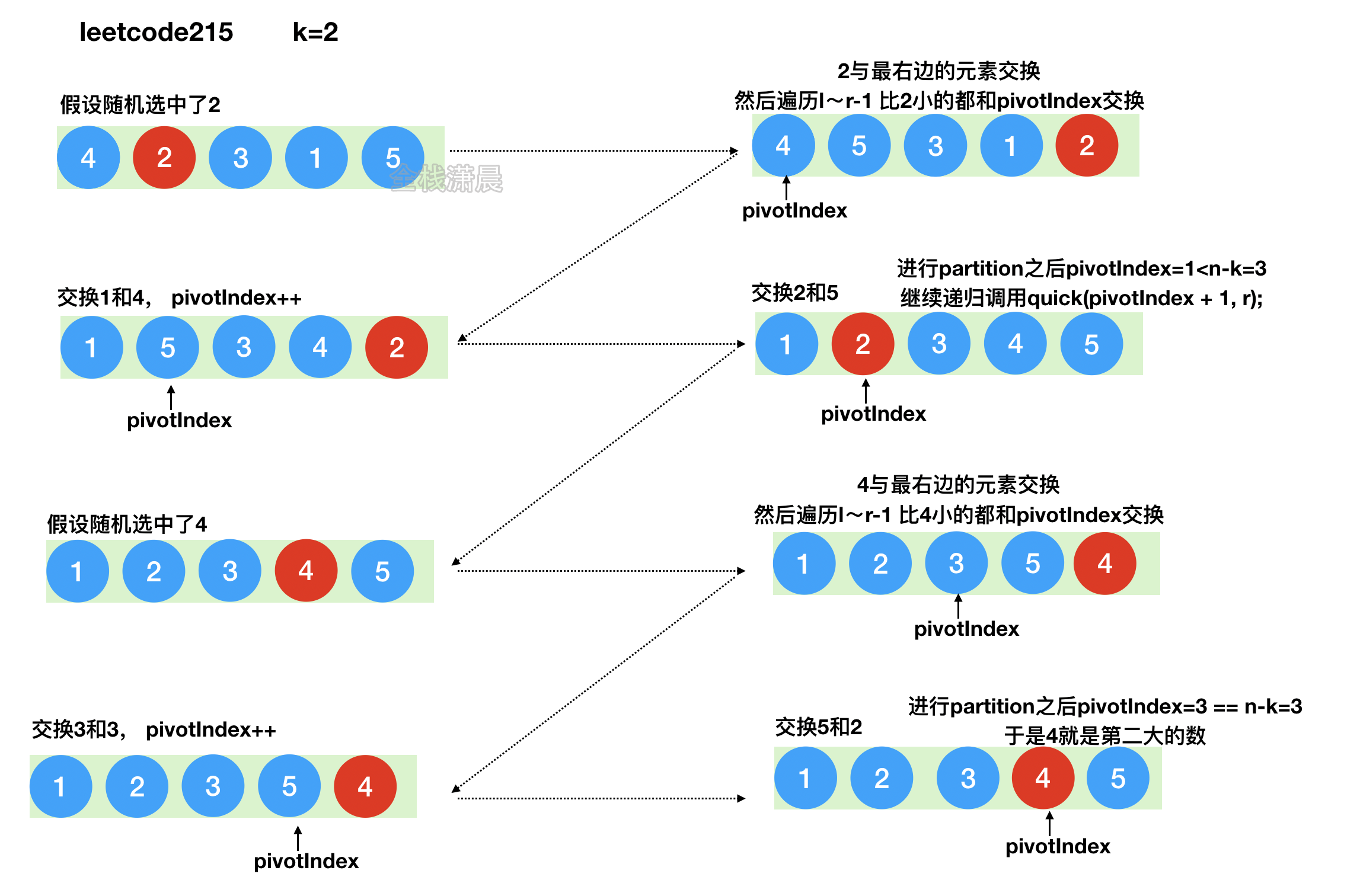
思路:借鉴快排的思路,不断随机选择基准元素,看进行 partition 之后,该元素是不是在
n-k的位置。复杂度:
时间复杂度
O(nlogn)空间复杂度
O(logn),递归的深度
js:
const findKthLargest = (nums, k) => { const n = nums.length;
const quick = (l, r) => { if (l > r) return;//递归终止条件 let random = Math.floor(Math.random() * (r - l + 1)) + l; //随机选取一个索引 swap(nums, random, r); //将它和位置r的元素交换,让nums[r]作为基准元素
//对基准元素进行partition let pivotIndex = partition(nums, l, r); //进行partition之后,基准元素左边的元素都小于它 右边的元素都大于它 //如果partition之后,这个基准元素的位置pivotIndex正好是n-k 则找大了第k大的数 //如果n-k<pivotIndex,则在pivotIndex的左边递归查找 //如果n-k>pivotIndex,则在pivotIndex的右边递归查找 if (n - k < pivotIndex) { quick(l, pivotIndex - 1); } else { quick(pivotIndex + 1, r); } };
quick(0, n - 1);//函数开始传入的left=0,right= n - 1 return nums[n - k]; //最后找到了正确的位置 也就是n-k等于pivotIndex 这个位置的元素就是第k大的数};
function partition(nums, left, right) { let pivot = nums[right]; //最右边的元素为基准 let pivotIndex = left; //pivotIndex初始化为left for (let i = left; i < right; i++) { //遍历left到right-1的元素 if (nums[i] < pivot) { //如果当前元素比基准元素小 swap(nums, i, pivotIndex); //把它交换到pivotIndex的位置 pivotIndex++; //pivotIndex往前移动一步 } } swap(nums, right, pivotIndex); //最后交换pivotIndex和right return pivotIndex; //返回pivotIndex}
function swap(nums, p, q) {//交换数组中的两个元素 const temp = nums[p]; nums[p] = nums[q]; nums[q] = temp;}
java:
class Solution { Random random = new Random();
public int findKthLargest(int[] nums, int k) { return quickSelect(nums, 0, nums.length - 1, nums.length - k); }
public int quickSelect(int[] a, int l, int r, int index) { int q = randomPartition(a, l, r); if (q == index) { return a[q]; } else { return q < index ? quickSelect(a, q + 1, r, index) : quickSelect(a, l, q - 1, index); } }
public int randomPartition(int[] a, int l, int r) { int i = random.nextInt(r - l + 1) + l; swap(a, i, r); return partition(a, l, r); }
public int partition(int[] a, int l, int r) { int x = a[r], i = l - 1; for (int j = l; j < r; ++j) { if (a[j] <= x) { swap(a, ++i, j); } } swap(a, i + 1, r); return i + 1; }
public void swap(int[] a, int i, int j) { int temp = a[i]; a[i] = a[j]; a[j] = temp; }}
148. 排序链表(medium)
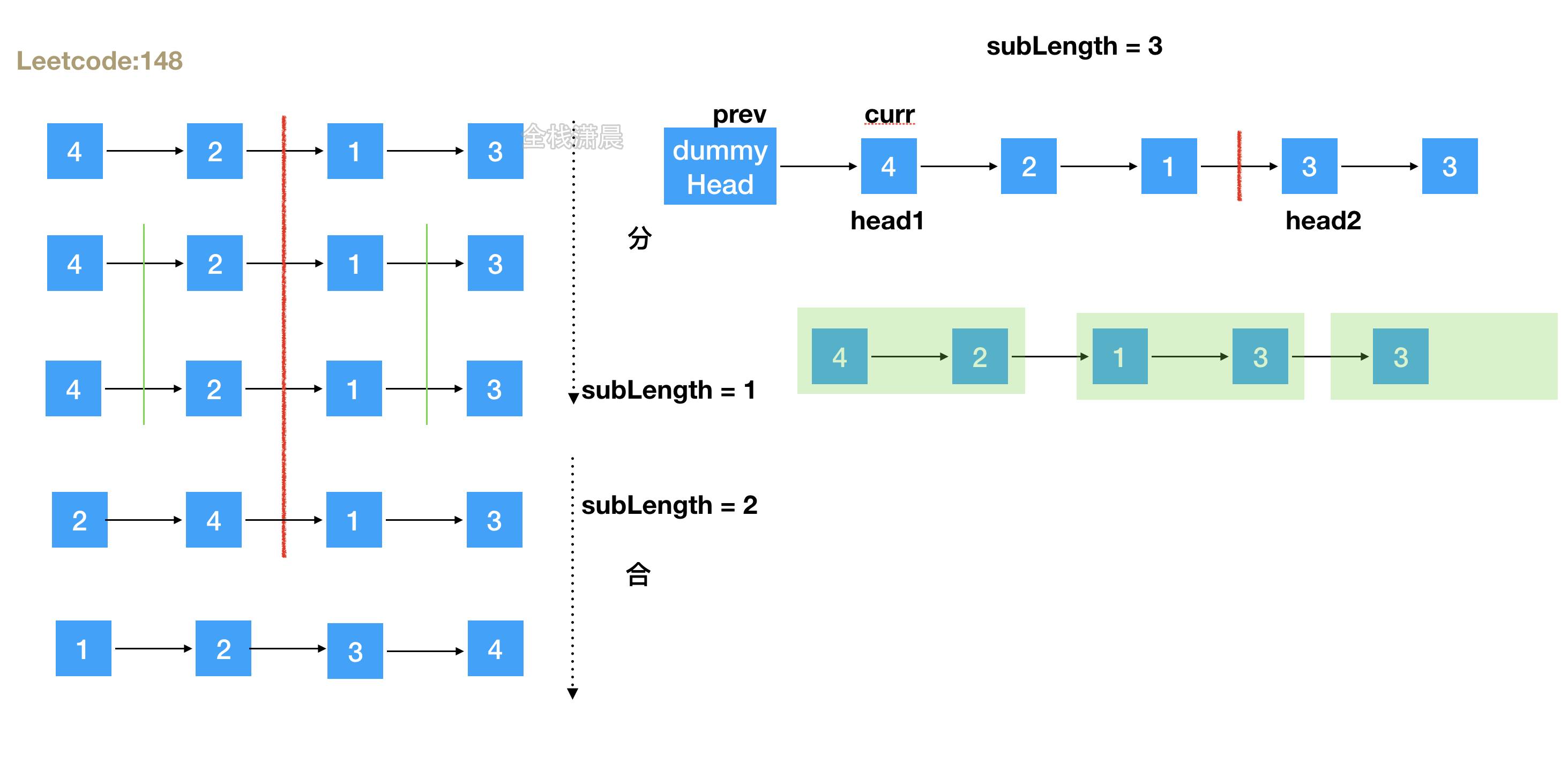
方法 1:自顶向下
思路:用归并排序的思路,先不断分割,知道每个子区间只有一个节点位置,然后开始合并。
复杂度:时间复杂度
O(nlogn),和归并排序的复杂度一样。空间复杂度O(logn),递归的栈空间
js:
const merge = (head1, head2) => { const dummyHead = new ListNode(0); let temp = dummyHead, temp1 = head1, temp2 = head2; while (temp1 !== null && temp2 !== null) {//合并子区间 小的节点先连 if (temp1.val <= temp2.val) { temp.next = temp1; temp1 = temp1.next; } else { temp.next = temp2; temp2 = temp2.next; } temp = temp.next; } if (temp1 !== null) {//两条链表还有节点没合并完,直接合并过来 temp.next = temp1; } else if (temp2 !== null) { temp.next = temp2; } return dummyHead.next;}
const toSortList = (head, tail) => { if (head === null) {//极端情况 return head; } if (head.next === tail) {//分割到只剩一个节点 head.next = null; return head; } let slow = head, fast = head; while (fast !== tail) {//的到中间节点 slow = slow.next; fast = fast.next; if (fast !== tail) { fast = fast.next; } } const mid = slow; return merge(toSortList(head, mid), toSortList(mid, tail));//分割区间 递归合并}
var sortList = function(head) { return toSortList(head, null);};
java:
class Solution { public ListNode sortList(ListNode head) { return toSortList(head, null); }
public ListNode toSortList(ListNode head, ListNode tail) { if (head == null) { return head; } if (head.next == tail) { head.next = null; return head; } ListNode slow = head, fast = head; while (fast != tail) { slow = slow.next; fast = fast.next; if (fast != tail) { fast = fast.next; } } ListNode mid = slow; ListNode list1 = toSortList(head, mid); ListNode list2 = toSortList(mid, tail); ListNode sorted = merge(list1, list2); return sorted; }
public ListNode merge(ListNode head1, ListNode head2) { ListNode dummyHead = new ListNode(0); ListNode temp = dummyHead, temp1 = head1, temp2 = head2; while (temp1 != null && temp2 != null) { if (temp1.val <= temp2.val) { temp.next = temp1; temp1 = temp1.next; } else { temp.next = temp2; temp2 = temp2.next; } temp = temp.next; } if (temp1 != null) { temp.next = temp1; } else if (temp2 != null) { temp.next = temp2; } return dummyHead.next; }}
方法 2:自底向上
思路:直接进行循环合并操作。
复杂度:时间复杂度
O(nlogn),空间复杂度O(1)
js:
const merge = (head1, head2) => { const dummyHead = new ListNode(0); let temp = dummyHead, temp1 = head1, temp2 = head2; while (temp1 !== null && temp2 !== null) { if (temp1.val <= temp2.val) { temp.next = temp1; temp1 = temp1.next; } else { temp.next = temp2; temp2 = temp2.next; } temp = temp.next; } if (temp1 !== null) { temp.next = temp1; } else if (temp2 !== null) { temp.next = temp2; } return dummyHead.next;}
var sortList = function(head) { if (head === null) { return head; } let length = 0; let node = head; while (node !== null) { length++; node = node.next; } const dummyHead = new ListNode(0, head); for (let subLength = 1; subLength < length; subLength <<= 1) { let prev = dummyHead, curr = dummyHead.next; while (curr !== null) { let head1 = curr; for (let i = 1; i < subLength && curr.next !== null; i++) { curr = curr.next; } let head2 = curr.next; curr.next = null; curr = head2; for (let i = 1; i < subLength && curr != null && curr.next !== null; i++) { curr = curr.next; } let next = null; if (curr !== null) { next = curr.next; curr.next = null; } const merged = merge(head1, head2); prev.next = merged; while (prev.next !== null) { prev = prev.next; } curr = next; } } return dummyHead.next;};
java:
class Solution { public ListNode sortList(ListNode head) { if (head == null) { return head; } int length = 0; ListNode node = head; while (node != null) { length++; node = node.next; } ListNode dummyHead = new ListNode(0, head); for (int subLength = 1; subLength < length; subLength <<= 1) { ListNode prev = dummyHead, curr = dummyHead.next; while (curr != null) { ListNode head1 = curr; for (int i = 1; i < subLength && curr.next != null; i++) { curr = curr.next; } ListNode head2 = curr.next; curr.next = null; curr = head2; for (int i = 1; i < subLength && curr != null && curr.next != null; i++) { curr = curr.next; } ListNode next = null; if (curr != null) { next = curr.next; curr.next = null; } ListNode merged = merge(head1, head2); prev.next = merged; while (prev.next != null) { prev = prev.next; } curr = next; } } return dummyHead.next; }
public ListNode merge(ListNode head1, ListNode head2) { ListNode dummyHead = new ListNode(0); ListNode temp = dummyHead, temp1 = head1, temp2 = head2; while (temp1 != null && temp2 != null) { if (temp1.val <= temp2.val) { temp.next = temp1; temp1 = temp1.next; } else { temp.next = temp2; temp2 = temp2.next; } temp = temp.next; } if (temp1 != null) { temp.next = temp1; } else if (temp2 != null) { temp.next = temp2; } return dummyHead.next; }}
全栈潇晨
还未添加个人签名 2021.02.17 加入
还未添加个人简介












评论